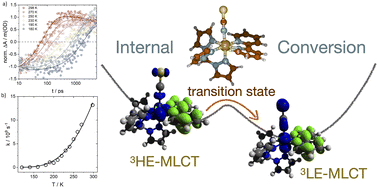Unusually high energy barriers for internal conversion in a {Ru(bpy)} chromophore†
Abstract
Internal conversion (IC) coupled to vibrational relaxation (VR) in molecular chromophores is a source of major energy losses in natural and artificial solar-to-chemical energy conversion schemes. The development of anti-Kasha chromophores, where dissipative IC channels are blocked, is a promising strategy to boost energy conversion efficiencies. In this contribution, we demonstrate the presence of an unusually high kinetic barrier for IC in [Ru(tpm)(bpy)(NCS)]+ (RuNCS), where tpm is tris(1-pyrazolyl)methane and bpy is 2,2′-bipyridine, by means of an arsenal of temperature-dependent spectroscopic methods including nanosecond and femtosecond transient absorption spectroscopies. These studies are complemented with theoretical investigations, that provide a detailed atomistic description of the dissipation process, including the electronic structures of the excited states involved. The observed IC is mainly a hole reconfiguration within the octahedral t2g set of the Ru ion, with contributions from a Ru to NCS charge transfer. Thus, in a Marcus picture, inner and outer reorganizations contribute to the observed barrier. The results presented here show that wavefunction symmetry within a molecular chromophore can be exploited to inhibit dissipative IC. Finally, guidelines for the design of anti-Kasha chromophores that prevent dissipation in energy conversion schemes, based on minimum energy conical intersection calculations, are provided.

- This article is part of the themed collection: 2022 PCCP HOT Articles


 Please wait while we load your content...
Please wait while we load your content...